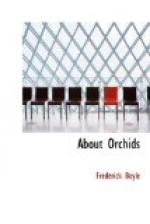Both the species of Renanthera need great heat. Among “facts not generally known” to orchid-growers, but decidedly interesting for them, is the commercial habitat, as one may say, of R. coccinea. The books state correctly that it is a native of Cochin China. Orchids coming from such a distance must needs be withered on arrival. Accordingly, the most experienced horticulturist who is not up to a little secret feels assured that all is well when he beholds at the auction-room or at one of the small dealer’s a plant full of sap, with glossy leaves and unshrivelled roots. It must have been in cultivation for a year at the very least, and he buys with confidence. Too often, however, a disastrous change sets in from the very moment his purchase reaches home. Instead of growing it falls back and back, until in a very few weeks it has all the appearance of a newly-imported piece. The explanation is curious. At some time, not distant, a quantity of R. coccinea must have found its way to the neighbourhood of Rio. There it flourishes as a weed, with a vigour quite unparalleled in its native soil. Unscrupulous persons take advantage of this extraordinary accident. From a country so near and so readily accessible they can get plants home, pot them up, and sell them, before the withering process sets in. May this revelation confound such knavish tricks! The moral is old—buy your orchids from one of the great dealers, if you do not care to “establish” them yourself.
R. coccinea is another of the climbing species, and it demands, even more urgently than V. teres, to reach the top of the house, where sunshine is fiercest, before blooming. Under the best conditions, indeed, it is slow to produce its noble wreaths of flower—deep red, crimson, and orange. Upon the other hand, the plant itself is ornamental, and it grows very fast. The Duke of Devonshire has some at Chatsworth which never fail to make a gorgeous show in their season; but they stand twenty feet high, twisted round birch-trees, and they have occupied their present quarters for half a century or near it. There is but one more species in the genus, so far as the unlearned know, but this, generally recognized as Vanda Lowii, as has been already mentioned, ranks among the grand curiosities of botanic science. Like some of the Catasetums and Cycnoches, it bears two distinct types of flower on each spike, but the instance of R. Lowii is even more perplexing.




